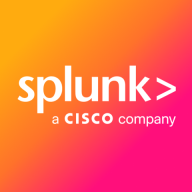

Find out in this report how the two Security Information and Event Management (SIEM) solutions compare in terms of features, pricing, service and support, easy of deployment, and ROI.
The solution is time-saving, particularly in the long run after it is deployed, enabling us to get value promptly.
The solution can save costs by improving incident resolution times and reducing security incident costs.
There is no UK-based support, which leads to delays in waiting for US support.
If I raise a ticket, it initially goes to the L1 team, but the next level of escalation is really effective.
They excel in response times and quick reactions when there's an actual threat.
Mission-critical offering a dedicated team, proactive monitoring, and fast resolution.
From the responsiveness perspective, Splunk is very responsive with SLA-bound support for premium tiers.
I would rate their technical support as 8.5 out of 10.
I can rate it around eight to nine, and it is very scalable and capable of handling tasks, especially for the on-premises product.
We have not had any customers come back to say they cannot scale at the speed of their business growth.
The solution is scalable as it is cloud-based and cloud-native.
Splunk User Behavior Analytics is highly scalable, designed for enterprise scalability, allowing expansion of data ingestion, indexing, and search capabilities as log volumes grow.
The stability of Securonix Next-Gen SIEM is based on the events we are processing.
With built-in redundancy across zones and regions, 99.9% uptime is achievable.
Splunk User Behavior Analytics is a one hundred percent stable solution.
Splunk User Behavior Analytics is highly stable and reliable, even in large-scale enterprise environments with high log injection rates.
At the admin level, we have many challenges where log parsing is causing issues and compatibility is not present.
The passing and setup are quite complex at the beginning, making onboarding not smooth.
SIEM could have better integration with other technologies.
Global reach allows deployment of apps and services closer to users worldwide, but data sovereignty concerns exist and region selection must align with compliance requirements.
I encountered several issues while trying to create solutions for this advanced version, which seem unrelated to query or data issues.
High data ingestion costs can be an issue, especially for large enterprises, as Splunk charges based on the amount of data processed.
Licensing is based on events per second (EPS), costing between $50 to $60 per EPS.
The solution is definitely not expensive.
The pricing has similar ingestion charges compared to other solutions, such as Splunk.
Reserved instances with one or three-year commitments offer lower rates, providing up to 70% savings.
Compared to all other products in the market, it is the most expensive one in all aspects including professional service and licenses, even the cloud version.
Comparing with the competitors, it's a bit expensive.
The software includes user behavior interactions, dashboards, and training capabilities.
Now, the process is automatic, reducing our workload.
The other SIEM solutions lack an option for big data analysis, whereas in the Securonix Next-Gen SIEM, we have this option.
I also utilize it for anomaly detection and behavior analysis, particularly using Splunk's machine learning environment.
The dashboards themselves are nice, very good, and very helpful, but the accuracy of the data or the information that will be presented on the dashboard is something that needs to be questioned.
Features like alerts and auto report generation are valuable.
| Product | Market Share (%) |
|---|---|
| Securonix Next-Gen SIEM | 1.1% |
| Wazuh | 9.3% |
| Splunk Enterprise Security | 8.7% |
| Other | 80.9% |
| Product | Market Share (%) |
|---|---|
| Splunk User Behavior Analytics | 7.6% |
| Exabeam | 9.0% |
| IBM Security QRadar | 7.8% |
| Other | 75.6% |


| Company Size | Count |
|---|---|
| Small Business | 10 |
| Midsize Enterprise | 5 |
| Large Enterprise | 19 |
| Company Size | Count |
|---|---|
| Small Business | 7 |
| Midsize Enterprise | 5 |
| Large Enterprise | 12 |
Securonix Next-Gen SIEM is a security information and event management solution designed to provide advanced threat detection, response, and compliance capabilities. It leverages machine learning and big data analytics to offer a comprehensive security platform for modern enterprises.
Securonix Next-Gen SIEM utilizes advanced analytics and machine learning to detect complex threats that traditional SIEM solutions might miss. Its architecture is built on Hadoop, enabling scalability and the processing of large volumes of data in real-time. This allows organizations to gain deep insights into security incidents, prioritize threats, and automate response actions. The solution also includes behavior analytics to detect insider threats and unknown attacks, integrating seamlessly with existing IT infrastructure.
What are the critical features of Securonix Next-Gen SIEM?
What is the ROI expectations?
Securonix Next-Gen SIEM is implemented across various industries, including finance, healthcare, and retail. Its flexibility and advanced analytics capabilities make it suitable for environments with complex security needs. In finance, it helps detect fraud, while in healthcare, it ensures patient data security. In retail, it protects against data breaches and payment fraud.
In summary, Securonix Next-Gen SIEM offers advanced threat detection, scalability, and integration capabilities, making it a robust solution for modern enterprises.
Splunk User Behavior Analytics is a behavior-based threat detection is based on machine learning methodologies that require no signatures or human analysis, enabling multi-entity behavior profiling and peer group analytics for users, devices, service accounts and applications. It detects insider threats and external attacks using out-of-the-box purpose-built that helps organizations find known, unknown and hidden threats, but extensible unsupervised machine learning (ML) algorithms, provides context around the threat via ML driven anomaly correlation and visual mapping of stitched anomalies over various phases of the attack lifecycle (Kill-Chain View). It uses a data science driven approach that produces actionable results with risk ratings and supporting evidence that increases SOC efficiency and supports bi-directional integration with Splunk Enterprise for data ingestion and correlation and with Splunk Enterprise Security for incident scoping, workflow management and automated response. The result is automated, accurate threat and anomaly detection.
We monitor all Security Information and Event Management (SIEM) reviews to prevent fraudulent reviews and keep review quality high. We do not post reviews by company employees or direct competitors. We validate each review for authenticity via cross-reference with LinkedIn, and personal follow-up with the reviewer when necessary.